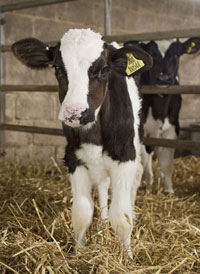Time to drop stigma of dairy meat

It may be shocking for some to discover that more than half of beef consumed in the UK comes from the dairy industry. But as soon as the words beef and dairy fall in to the same sentence, it is automatically assumed the product is going to be second class.
However, this image of dairy beef as a second-class product needs to change, says beef farmer and founder of Sterling Sires, Paul Westaway. “There is a stigma that suckler beef is better than Holstein cross beef, but this isn’t the case. When genetics and rearing conditions are right then it can be just as good.”
And genetics and colostrum intake are crucial to getting a good beef animal from the dairy herd, says Somerset dairy farmer David Bown, who is selling about 120 dairy beef calves a year, at four weeks old.
“Colostrum and genetics are two things that will affect the value of dairy beef calves. When dairy beef cross calves are born, the attention to detail is the same as when it is a dairy heifer replacement,” says Mr Bown, who has been producing dairy beef crosses for the past 20 years.
“When you don’t get an adequate amount of colostrum into those calves in the first few hours of life, then it’s likely they won’t survive. And since we sell mainly to the same buyer every month it’s important our calves are consistent – you get a lot more money for a well-looked-after calf,” he says.
Correct genetics plays another major factor and using genetics that are not going to damage the cow at calving are vital. Mr Bown uses both Belgian Blue as well as Aberdeen Angus on his cows, with all animals coming into heat between January and April put to beef.
“This fits in well with our system because it means we can rear batches of calves in groups of fives and then 25s, which is easy to manage, so about 120 out of our 370 cows are put to beef.”
And ensuring sires are easy calving is the number-one priority, he adds. “Even when this means calves may be born smaller, as long as they don’t damage the cow and as long as they frame up at about three weeks, then that is all we want.”
And two beef breeds are being used because the smaller Aberdeen Angus is used on heifers, whereas the larger Belgian Blue is used on cows. “We like the Belgian Blue because we find they are not only easy calving, but they also have a shorter gestation length than a Charolais, for example, of about seven days,” he explains. The two Aberdeen Angus bulls are then used on heifers in the summer.
When Mr Bown is selecting genetics he not only pays attention to looks, but also EBVs. “When selecting Angus bulls, I do look at EBVs for calving ease, but I also go on looks. The shape of a bull can give some good clues about calving ease. When they have great front ends that is normally a good sign.”
And despite two beef genetics, a good-quality product is produced from both. “If I was selling just a Holstein bull calf then I would be averaging no more than £30. This is not economical – when you consider the rearing costs are about £50/calf, you need to be making in excess of £70 a calf to make a decent margin.”
The best of Mr Bown’s Angus calves would sell for about £250/calf at 55kg and it is not unheard of that he could sell three Belgian Blues for £1000 at 65kg each.
“So when attention is paid to genetics and rearing there is definitely a profit to be made,” he says.
